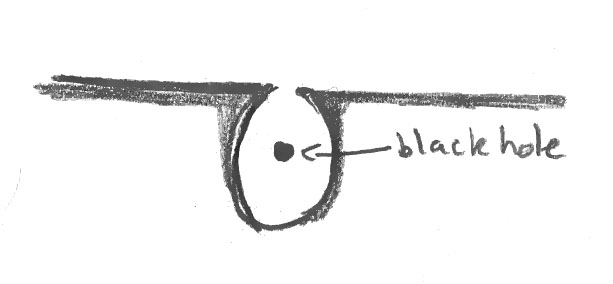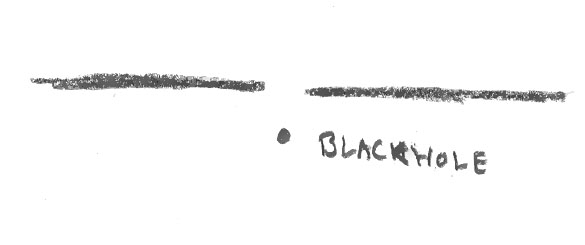
More about Black Holes
There is so much more….I cannot even begin to cover the stuff..but I'm trying not to be boring, so I must, I must, I must be succinct. (Sad isn't it?) But I can say a couple more little things that might interest you.
First of all…when I showed you the blanket analogy, there are two possibilities. One, that the blanket is merely wrapped around the black hole, so light is going in, but its just trapped there. Two, that the black hole stretched the fabric of space-time so much that where the black hole exists…there is a hole.....and when there is a hole in the universe, is there something on the other side? We just don't know whether the universe forms a hole or a pocket, or if it does form a hole, what is on the other side.


Measuring the gravitational mass of an object which not only is so immense I'm
not even sure if we have large enough numbers, but is also surrounded by a glowing
accretion disk spinning at improbably high speeds is downright difficult. The
only way I could think of would be to attempt to model the accretion disk and
calculate the rotational acceleration and relate that to the gravitational attraction
of the black hole.
Oh! I forgot! All those pretty pictures on the other pages …haven't you thought, "if those are pictures of black holes, and you can't see them because light can't escape them, that why can we see them?" Well, the disks of flaming suns and whatnot are accretion disks, the matter that is irresistibly attracted to the black hole but hasn't gone into the pocket/hole of space-time.
Another peculiar piece of physics about black holes---time dilation. Remember I said that black holes distort space time? And remember that space time is time and space, inextricably bound together? I told you about the overall effect, but not two subeffects-time dilation and stretching. First…for an observer on the rim of the black hole (if that were possible) a person being sucked down into it would appear to be stretching into an infinite length. Also, to the trapped individual…it takes only a couple of minutes to actually be sucked into the black hole and die (which is inevitable) but the outside observer never actually sees the trapped inividual get sucked in because light is actually slowed by the intense gravitational force. At the point where he'd get sucked in, light can't travel back to give the observer the sight. Theoretically, however, if the black hole were to become unstable and die, that last sight of the death of the individual would be ejected back outwards and visible to an observer...but only at the instant of the black hole's death.
Well, I can't write too much or I'll get in trouble!
If you liked hearing about black holes, the Chandra observatory has a lot more information and pictures on work they are doing on the subject. However, if you want to learn more about the physics of black holes, I'd recommend starting out with my personal favorite…Stephen Hawking's book A Brief History of Time.
Adieu!
Introduction
Colliding Black Holes
Curved Space-Time
Bibliography
Sources